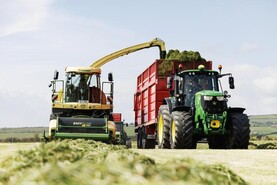In the West of Ireland, it’s very rare for us to look for rain, and that rare occasion has now happened. With next to no rain and intense heat for close to a month, growth rates right across the country have dipped in the past week, with a further fall in growth of roughly 10kg DM/ha forecast for the week ahead.
There is hopefully some reprieve on the way, with some rain and showers forecast for the week ahead. Going by past droughts, these could be very localised and you could be lucky or unlucky with how much rain you get.
At this point, those in the traditionally drier counties will likely have to see what supplementation will have to go alongside meal in the parlour.
Dairy farmers I’ve talked to in the last two weeks have increased meal levels to 4kg in an effort to stave off running out of grass. With the further dip in growth, silage or zero grazed grass will likely now have to be introduced.
If grass on an outside block is available, such as from early-cut silage blocks, an option would be to zero graze in some of this and feed along the barrier at milking time.
It’s likely a cheaper option than feeding surplus bales for many. If surplus bales are being fed, try and put a figure on what amount of dry matter is being fed. The dry matter of bales generally runs between 200kg and 240kg, so two bales/day will provide 4kg to 5kg of DM to a 100-cow herd.
Combining this with 4kg of meal in the parlour, grass requirements are back down to between 9kg and 10kg, and with a stocking rate of say 3.5LU/ha, a growth in the mid-30s will sustain farm cover for the foreseeable future.
Those in the western and northern half of the country should also be mindful of the slow down in growth.
Priority stock, such as finishing animals and spring lambs and calves, should not be restricted in growth
A lot of first-cut silage and paddocks have now been harvested, and the leaf quantity of swards is running low.
Where quality is becoming an issue, assess the farm cover and see if paddocks can continue to be baled up or if pre-mowing is a better option.
On drystock farms, there isn't the luxury to increase meal levels across the board so easily.
Priority stock, such as finishing animals and spring lambs and calves, should not be restricted in growth.
However, if there are stock that can be offloaded from the block, such as cull cows or forward stores, this might be an option.
Autumn-born weanlings should now be removed, and it's best practice anyway to keep autumn-calving cows on a restricted diet, so this is another option.






 This is a subscriber-only article
This is a subscriber-only article











SHARING OPTIONS: